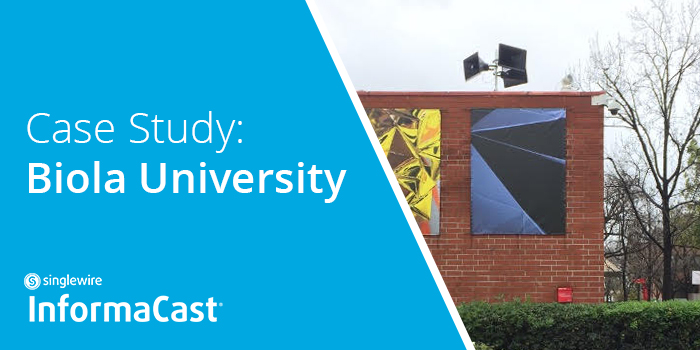Founded in 1908, Biola University is a nationally ranked university in La Mirada, Calif. Spread out across 95 acres, the campus has 40 major buildings serving over 6,000 students.
The Challenge
With limited time, budget, and resources, Biola University’s IT team needed to update its campus alerting system so critical notifications were delivered to more than just people’s mobile devices.
The Solution
The campus deployed InformaCast to help expand the reach of its emergency alerts to outdoor speakers and has used a phased implementation to regularly add functionally to provide more effective notifications.
Addressing Safety and Security Needs
No campus safety project is easy to accomplish, but when time, budget, and resources are scarce, difficult can quickly shift to impossible. No one knows this better than Scott Himes, director of network operations for Biola University in La Mirada, California.
“Following a lockdown test that sent messages to people’s mobile devices, our team realized that the alerts were not as effective as we would have hoped,” said Himes. “We were tasked to implement a new way to reach people within three months for a follow-up test.”
In many cases students and faculty were not aware of the test unless they were looking at their cell phones or emails at the exact moment the alert was sent out. It became evident that the campus needed another way to get people’s attention when an emergency was taking place.
He and his colleagues went to work trying to find a vendor that would help them integrate everything while building off the university’s existing infrastructure. This would help avoid adding another standalone system to manage and activate during a crisis, which lessened the overall scope of the project. Himes also decided to focus the test on a single beta site that could be replicated in other areas of campus, rather than trying to implement a campus-wide solution all at once.
Implementing Mass Notification
This led Himes to InformaCast mass notification software. Following a demo, Himes knew InformaCast could help solve his short-term challenge of delivering audible alerts to key areas, while also discovering features that could benefit the university down the road, like emergency call alerting and blue light phone integration.
After scouting the campus, Himes and his colleagues were able to identify a major thoroughfare that would serve as an optimal test site. They installed an outdoor speaker at the site, and connected it to InformaCast, nearly a month ahead of their scheduled drill. This allowed them time to conduct testing before the drill and identify and correct issues to ensure everything worked as intended. The project was completed on time and the drill was conducted successfully with audible alerts delivered to a key area of campus, so people were aware of what was happening.
Expanding Integrations
Himes credits the university’s success to multiple teams working towards a common goal.
“Protecting students and faculty, isn’t the sole responsibility of the campus safety team,” said Himes. “It requires collaboration between campus safety, IT, facilities and other stakeholders to build relationships that span departments so everyone is invested in a positive outcome.”
This collaborative atmosphere has allowed Himes and his colleagues to expand their usage of InformaCast beyond the initial problem they were trying to solve. This included replacing an aging panic button system.
“We were using about a half dozen different models connected to analog phones lines,” said Himes. “This often meant there were varying degrees of usability and response times were slow.”
Himes and his colleagues were interested in standardizing deployment so there was clear delineation between where a standalone panic button would be used and where a virtual panic button on a phone would be sufficient. Using InformaCast, the university set up speed dials on phones and integrated with Cyberdata SIP call buttons. This provided a reliable and immediate way to alert Biola’s call center that an issue was taking place.
“With our old system, it could take upwards of three minutes for someone to know a panic button had been activated,” explained Himes. “Now, the moment a panic button is triggered, our dispatchers get a desktop pop-up on their PC with information about which panic button was activated.”
Himes has continued to expand desk phone and speaker integrations and has even connected InformaCast with blue light poles around campus that can also serve as speakers to broadcast emergency messages.
Earthquake Readiness
One of the more unique applications Biola University is using InformaCast for is earthquake readiness. Early Warning Labs is an official US Geological Survey partner that can alert people of impending tremors before they arrive. These few seconds of warning can make a big difference when it comes to getting people out of harm’s way.
Following an earthquake in July of 2019, Himes learned about the partnership between Early Warning Labs and InformaCast. He and his team were able to get approval and add the integration to the university’s campus safety toolbox. Just two months after learning about the integration, Himes successfully installed and tested it on campus.
Future Phases
With a strong foundation in place, Himes plans to continue building out the university’s use of InformaCast with additional PA speaker integrations to ensure it is reaching as many people as possible during a crisis. This includes adding indoor speakers, as well as configuring InformaCast messages to take over classroom screens and other digital signage around campus.
“The goal is to add integrations in phases to make our mass notification as effective as possible,” said Himes.
Visit our Colleges & Universities page for more information about how campuses can implement InformaCast to help with their safety and alerting needs.
